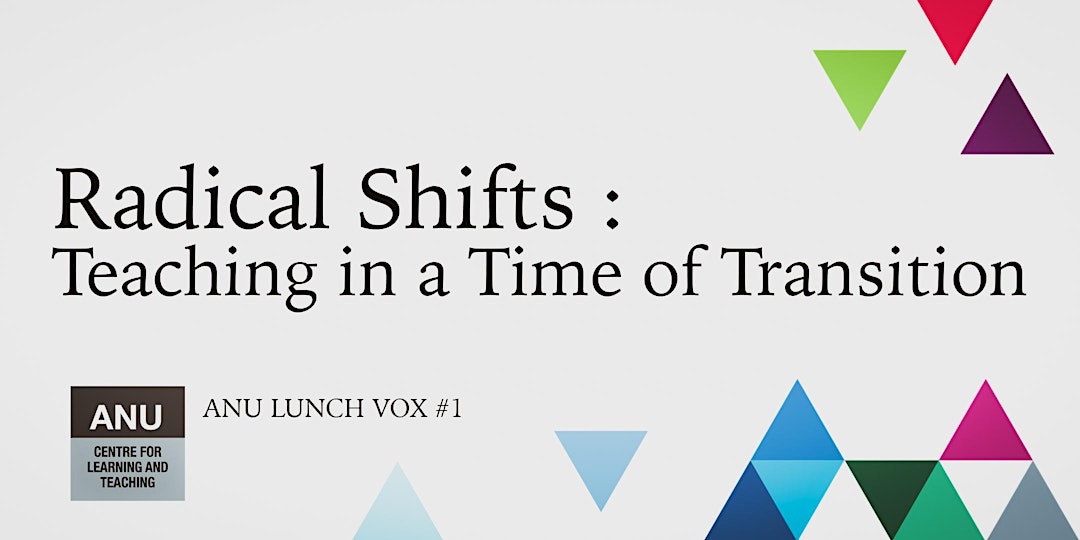 The ANU Lunch Vox is a webinar series on teaching and learning. The first is Radical Shifts: Teaching in a Time of Transition, 20 August. Participants have been asked four questions and invited to produce 30 second video answers, so here are mine, all together, or one at a time:
The ANU Lunch Vox is a webinar series on teaching and learning. The first is Radical Shifts: Teaching in a Time of Transition, 20 August. Participants have been asked four questions and invited to produce 30 second video answers, so here are mine, all together, or one at a time:- What is one activity/teaching strategy that you will continue to use once we return to face to face learning?
- How have your colleagues helped you through the transition to online learning?
- What are the key differences in teaching online and teaching remotely that an educator should be aware of?
- What is one positive message you think all ANU educators should hear in a time of transition? (CC)

What I normally do is produce the slideshow videos with synthetic voice for a course in advance. Then, if there is a live presentation, in a classroom or online, record that as well and prove that recording to the students after the presentation. The synthetic voice has the advantage of being precisely the same as the script and can be easily changed without the need to rerecord or edit. Also I suspect it is easier for those with English as a second language to understand the synthetic voice than my voice. However, while synthetic voices have got much better they are still mechanical sounding. On the other hand a live performer can sound wooden, as I do there, without an audience to respond to:
Part One: A Strategy Back to the Classroom.
"I plan to use hybrid mode: with some students in the classroom, linked to those on-line.
But we must be ready to abandon the classroom, without warning, due to COVID-19 outbreaks.
I stopped "lecturing" ten years ago and moved my teaching online.
Most students had already abandoned lectures, years before COVID-19.
Last year I supplemented my on-line teaching with some classroom based workshops.
But many of the students were international and a regional crisis could keep them away.
So I planned an online alternative, just in case.
That plan worked when COVID-19 struck."
Part Two, How Colleagues helped?
"During this difficult time of COVID-19 I have found the informal online events run by colleagues very useful to stay in touch.
Especially useful have been the Australian National University's weekly virtual morning teas, for early career academics.
Also Friday mornings with the Mobile Learning Special Interest Group of the Australasian Society for Computers in Learning in Tertiary Education have been productive.
We wrote a joint paper for the Society's upcoming national conference.
The Australian National University's Coffee Courses have been thought provoking, as well as useful for e-learning tips. "
Part Three: Differences teaching on-line?
'It is the similarities which are key, not the differences.
Teaching is teaching, whatever the medium.
Most importantly, educators should be trained to design and deliver education.
Teachers should learn using the techniques we want them to use, firstly online.
An approach called "dogfooding".
With training it is possible to design for online delivery and blend in classroom teaching, as required. '
Part Four: One positive message?
'At an Australian National University staff COVID-19 meeting early in 2020, I found myself saying to my colleagues:
"We can do this".
Staff have been provided extensive training and support to teach under these difficult circumstances. That support will continue as we establish new ways of teaching for the long term.
The university supported and encouraged me over several years to learn how to teach online.
One reason was in case students were kept from class by an international crisis.
I was able to trial those techniques last year, so they were ready, when needed this year, for COVID-19.
With the support of our colleagues we can transition to blended and hybrid education, incorporating classroom teaching.'
No comments:
Post a Comment